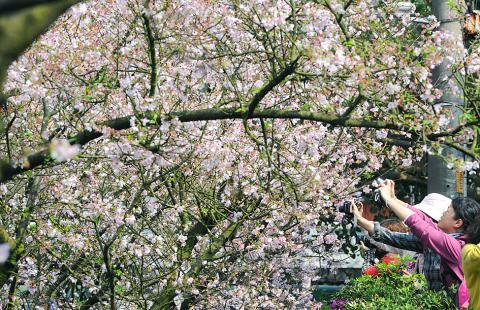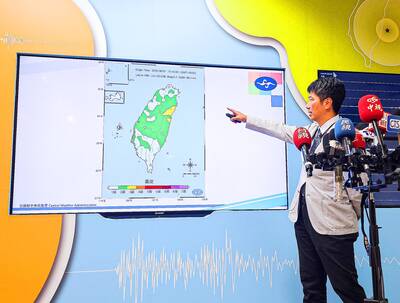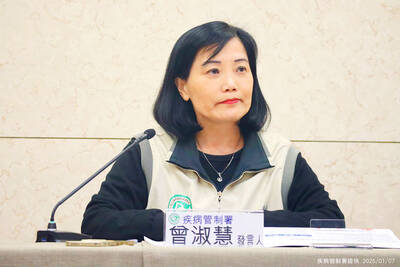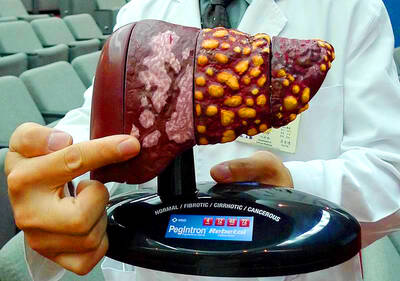Taiwan loves cherry blossoms. In fact, it loves almost everything Japanese. For a nation that ruled Taiwan for 50 years, often with an iron fist, Japan has left a very favorable impression.
In the latest triumph of Japanese soft power in its former colony, tens of thousands of Taiwanese have taken up planting cherry trees to revel in their colorful bloom for a few precious moments each spring — just like in Japan.
“When you see the flowers, you almost feel as if you are in Japan,” 50-year-old businesswoman Susan Wu said as she walked up a hilly road flanked by white and pink cherry blossoms in Beitou District (北投), Taipei.

Photo: AFP
In an annual routine that has become increasingly popular over the past two or three years, Taiwanese flock to remote sightseeing spots at the risk of being trapped in huge traffic jams just to catch a glimpse of the cherry blossoms, known as sakura in Japan.
The mountainous Beitou area has become a particular magnet for visitors after a local official started a campaign urging locals to plant cherry blossom trees, which has so far caught the imagination of more than 400 households.
“Not many people knew this place in the past, but now it’s famous because people associate it with cherry blossoms,” said Ching Rong-hui, an official who oversees the daily administration of Beitou’s cherry blossom area.
Other parts of Taiwan have joined the trend, putting money in the pockets of farmers in Sanchih (三芝), a rural area outside Taipei that now supplies up to 600,000 cherry tree saplings a year.
“Lots of our cherry tree farmers have benefited from the booming demand,” said Chou Zheng-nan, an official at the Sanchih Farmers Association, who declined to provide figures.
Japan is known to use cherry trees as a gesture of goodwill, and in Washington, one beneficiary of Tokyo’s flower power diplomacy, the blossom season is an annual party highlight.
However, in Taiwan, it is more than that. Analysts say the obsession with sakura — a key symbol of Japanese civilization — is a measure of the enormous cultural clout Japan wields in the country, second only to China in its impact.
“Japan’s influence has been huge, ranging from infrastructure to local people’s mindsets and behavior,” said Lee Shiao-feng (李筱峰), a professor of Taiwanese culture at the National Taipei University of Education.
China’s last weak imperial dynasty “ceded” Taiwan to Japan in 1895 after a brief, but disastrous war. Japan surrendered control over Taiwan at the end of World War II.
The first years under the Japanese around the turn of the last century were harsh and scattered resistance was crushed brutally, but then the new pith-helmeted administrators went on to develop Taiwan economically.
They built a railroad linking the north and south, constructed harbors and power plants, eradicated disease and boosted literacy rates, while also passing on their own cultural habits, such as baseball.
“Japan’s development projects laid the foundation for Taiwan to move into a pre-modern society,” Lee said. “In the process, Taiwanese gradually learned to play baseball as well as appreciate cherry blossoms and revel in hot springs, as they tried to imitate their rulers.”
Since 1945, the Japanese influence has continued nearly unabated and has been embraced by Taiwan’s younger generations, exposed to Japanese soap operas, pop music and TV programs featuring Japanese cuisine and sight-seeing spots, he said.
This is entirely different from the Korean Peninsula, which was ruled as a Japanese colony from 1910 to 1945 and is still haunted by memories of how brutal and harsh life was under the banner of the Rising Sun.
The Japanese did promote cherry blossoms, too, and South Korea has kept that particular tradition, but in a telling twist, it has replaced the Japanese trees with indigenous ones.
The contrast with Taiwan is obvious and yet academics in Taiwan say it might take the country’s cherry blossom lovers some time to digest the philosophical connotation of the cherry blossoms in Japanese culture.
“When Taiwanese appreciate cherry blossoms, they are simply impressed by the beauty of the flowers. That’s it,” Maa Yaw-huei (馬耀輝), director of the Department of Japanese at Taipei’s Tamkang University.
“However, in the eyes of their Japanese counterparts, there’s a sense of sadness associated with the transient beauty. Watching the fading of such pretty flowers is associated with mortality,” Maa said.
Taiwanese may behave like the Japanese, but do not think like them, observers say.
Chinese culture, first introduced from China more than three centuries ago, survived Japan’s colonization despite policies aimed at turning Taiwanese into loyal subjects of the Japanese emperor.
“Although the Japanese have added new cultural elements to Taiwan, the structure of Chinese culture has remained intact,” Lee said.

The Taipei Summer Festival is to begin tomorrow at Dadaocheng Wharf (大稻埕), featuring four themed firework shows and five live music performances throughout the month, the Taipei Department of Information and Tourism said today. The festival in the city’s Datong District (大同) is to run until Aug. 30, holding firework displays on Wednesdays and the final Saturday of the event. The first show is scheduled for tomorrow, followed by Aug. 13, 20 and 30. To celebrate the 30th anniversary of Disney Pixar's movie Toy Story, the festival has partnered with Walt Disney Co (Taiwan) to host a special themed area on

Aftershocks from a magnitude 6.2 earthquake that struck off Yilan County at 3:45pm yesterday could reach a magnitude of 5 to 5.5, the Central Weather Administration (CWA) said. Seismological Center technical officer Chiu Chun-ta (邱俊達) told a news conference that the epicenter of the temblor was more than 100km from Taiwan. Although predicted to measure between magnitude 5 and 5.5, the aftershocks would reach an intensity of 1 on Taiwan’s 7-tier scale, which gauges the actual effect of an earthquake, he said. The earthquake lasted longer in Taipei because the city is in a basin, he said. The quake’s epicenter was about 128.9km east-southeast

BE CAREFUL: The virus rarely causes severe illness or death, but newborns, older people and those with medical conditions are at risk of more severe illness As more than 7,000 cases of chikungunya fever have been reported in China’s Guangdong Province this year, including 2,892 new cases last week, the Centers for Disease Control (CDC) yesterday said it is monitoring the situation and considering raising the travel notice level, which might be announced today. The CDC issued a level 1 travel notice, or “watch,” for Guangdong Province on July 22, citing an outbreak in Foshan, a manufacturing hub in the south of the province, that was reported early last month. Between July 27 and Saturday, the province reported 2,892 new cases of chikungunya, reaching a total of 7,716

STAY VIGILANT: People should reduce the risk of chronic liver inflammation by avoiding excessive alcohol consumption, smoking and eating pickled foods, the physician said A doctor last week urged people to look for five key warning signs of acute liver failure after popular producer-turned-entertainer Shen Yu-lin (沈玉琳) was reportedly admitted to an intensive care unit for fulminant hepatitis. Fulminant hepatitis is the rapid and massive death of liver cells, impairing the organ’s detoxification, metabolic, protein synthesis and bile production functions, which if left untreated has a mortality rate as high as 80 percent, according to the Web site of Advancing Clinical Treatment of Liver Disease, an international organization focused on liver disease prevention and treatment. People with hepatitis B or C are at higher risk of